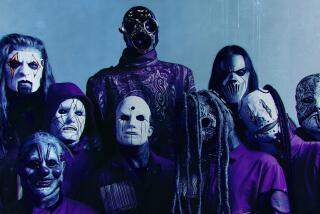‘Dark Night of the Soul’ can be seen but not heard
- Share via
Call it this year’s most notable cross-species creative partnership: When Grammy-winning studio whiz Danger Mouse reached out to musical surrealist Sparklehorse about a possible collaboration in 2004, the stated intention was to make music, not art.
But that’s not exactly how things panned out.
After roping in 11 indie rock and alt-country star pals on two continents to contribute guest vocals, the duo produced an album’s worth of atmospheric soundscapes. Then Danger Mouse, who is one-half of the hip-hop-psych-soul duo Gnarls Barkley, called on idiosyncratic director David Lynch to “visually interpret” the tunes with photos.
Many of Lynch’s 53 images are theatrically stage-lit and peopled with costumed extras in intimate, transitional moments. Others capture scenes of suburban torpor, skid row decrepitude and giddy enactments out of some weird hyper-realm.
“The photographs are a representation of what went on in my head when I heard the songs,” said Lynch. “It all came from the music.”
The fruit of the trio’s labor is a multimedia gallery installation titled “Dark Night of the Soul,” opening today at Michael Kohn Gallery in L.A. A limited-edition bound book of Lynch’s imagery of the same name was released earlier this month. And in a widely Twittered-about ongoing dispute between Danger Mouse’s management and his record label, EMI, the music has been embargoed from distribution.
The project began when Danger Mouse, a.k.a. Brian Burton, met the manager for Sparklehorse, a.k.a. Mark Linkous, at the South by Southwest Music Festival in Austin, Texas, in 2004. Burton told her how much he admired the reclusive musician’s ability to marry “harsh distorted sound and static” with the delicate nature of his voice. Afterward, the manager passed Linkous a CD of Burton’s breakthrough recording, the so-called Gray Album, his bootleg mash-up of the Beatles’ “White Album” with rap a cappellas from Jay-Z’s “The Black Album.”
It set the two on a collision course.
“I thought the music was fantastic without knowing anything about who Danger Mouse was. I thought it was a band,” Linkous recalled. “[Burton] said he was a fan and wanted to take my music in another direction. And he said, ‘Don’t be surprised if I’m at your studio next week.’ I live in the middle of nowhere in North Carolina. But there he was.”
Burton acknowledged that his motives weren’t totally unselfish. “Back then, people I wanted to work with were people I wanted to learn from,” he said. “Rather than try my best to copy him sound-wise, I wanted to learn to see how he did what he did -- in songwriting and in sound.”
The initial result was four songs on Sparklehorse’s favorably reviewed 2006 album, “Dreamt for Light Years in the Belly of a Mountain.” But the two exacting musician-producers -- both known for demanding final say behind the studio control console -- felt a kind of musical kinship.
Near the end of recording, Linkous, 42, and Burton, 31, hatched the idea to record their own album but clashed on what animal hybrid to name their outfit after. “I always liked Sparkle Mouse. He liked Dangerhorse,” Burton said.
When most of the tracks were done, the two solicited help from friends from across the musical spectrum to provide vocals: Julian Casablancas of the Strokes; Iggy Pop; James Mercer, singer-guitarist for the Shins; Nina Persson of the Cardigans; Suzanne Vega; Grandaddy chief songwriter Jason Lytle; Wayne Coyne and Steven Drozd of the Flaming Lips; Black Francis, formerly of the Pixies; singer-songwriter Vic Chesnutt; and Gruff Rhys from Super Furry Animals.
Hatching the ‘eggs’
Linkous and Burton said they did not compose the music with any specific artists in mind. “We’d try to make a song ‘nest’ for our friends to sing in,” Linkous said. “They would lay an egg in it. It would hatch and turn into a real song.”
The producers never issued direct orders about what to sing and never played the singers one another’s songs. Nonetheless, each performer’s contributions were of a piece -- emotionally pregnant ballads of Gothic sweep and lo-fi scope that ooze with fuzzed-out, hip-hop-inspired beats.
In the book’s introduction, Burton marvels at the way their lyrics all somehow deal with “pain, revenge, war, twisted dreams and other beautifully haunting visual aspects.”
“It was funny to us that darker elements came out from those people, even though a lot of their songs don’t have that aesthetic. It’s unexplainable,” said Linkous. “Maybe that’s what dark matter is. Maybe that’s what the God particle is.”
During recording, Burton had pondered a visual dimension but kept the idea to himself. In search of an outside collaborator who would “be able to articulate what’s drawing it all together,” he impulsively contacted Lynch.
Burton wrote the director a letter explaining that he hoped Lynch would contribute “something visual that could spark imagination” to accompany the songs. And Lynch -- who began recording music for himself two years ago and sings two of his own songs on the soundtrack for his 2006 film “Inland Empire” -- invited Burton over.
He knew of Gnarls Barkley but wasn’t entirely sure who Burton was. “I was thinking, ‘Is he coming up here to ask me about singing?’ ” Lynch recalled.
Once he heard the songs, Lynch agreed to participate. After a month of planning, he and Burton took to the streets of L.A. for a two-day shoot. The producer gave no creative direction but personally bankrolled the costs of casting, lighting and wardrobe; at certain points it involved a crew of 30 production assistants and extras.
“It was just like working on a film,” said Lynch. “We had to build some things. Or you find locations and people that fill the requirements.”
‘This never happens’
For the exhibition, groups of three to six photographs are arranged around the gallery, while the songs play in a loop. A small box containing a blue light illuminates to indicate which group of images corresponds with the music.
“In art world talk, this is a sound-and-vision installation,” said gallerist Michael Kohn. “To have three artists so high up on the totem pole in their respective disciplines collaborate to make extremely beautiful and meaningful work -- this never happens.”
For fans of Danger Mouse and Sparklehorse, however, the exhibition serves another purpose. It is one of the only places to hear the songs from “Dark Night of the Soul,” because of the disagreement between Burton -- who is obligated to deliver one more album to his label -- and EMI about the terms of commercially distributing the CD.
“Danger Mouse is a brilliant, talented artist for whom we have enormous respect,” EMI said in a statement. “We continue to make every effort to resolve this situation and we are talking to Brian Burton (Danger Mouse) directly. Meanwhile, we need to reserve our rights.”
And though Burton won’t speak directly about the conflict, his spokesperson said, “Danger Mouse is unable to release the recorded music for ‘Dark Night of the Soul’ without fear of being sued by EMI.”
The CDs included in the project’s limited-edition book are blank but labeled: “For legal reasons, enclosed CD-R contains no music. Use it as you will.”
For Linkous, that outcome is a sad coda to what he calls a rewarding creative collaboration. “It’s really discouraging. It took a long time to make. We worked really hard on it. And I’m proud of it. But I don’t know how people are going to get it.”
More to Read
The biggest entertainment stories
Get our big stories about Hollywood, film, television, music, arts, culture and more right in your inbox as soon as they publish.
You may occasionally receive promotional content from the Los Angeles Times.











